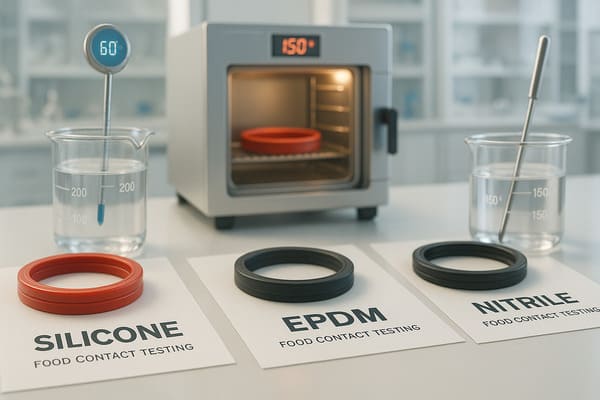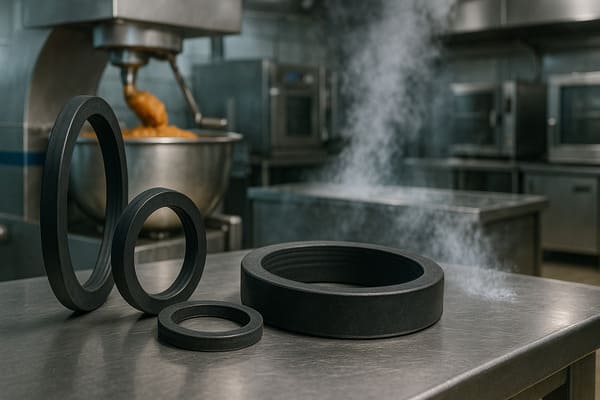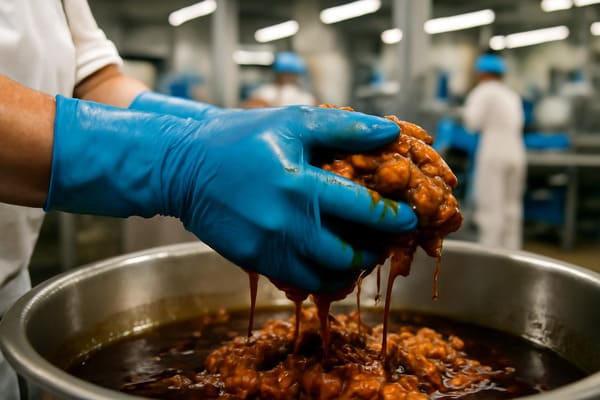In the food industry, selecting the right materials for production and packaging is crucial to ensure safety, compliance, and durability. When it comes to rubber, choosing the right type can significantly impact both food quality and operational efficiency. Let's explore which types of rubber are most commonly used in the food industry.
The most common types of rubber used in the food industry are silicone, EPDM, and nitrile (NBR), each offering unique properties like temperature resistance, flexibility, and safety for direct contact with food.

When choosing rubber for food-related applications, there are a few important considerations to keep in mind, such as compliance with safety standards and the material's ability to withstand varying temperatures. Let’s break down the best types of rubber for use in the food industry.
What Is Silicone Rubber?
Silicone rubber is a popular material in the food industry, thanks to its excellent temperature resistance, non-toxicity, and versatility. Let's take a deeper look at why silicone rubber is often used in food processing and packaging.
Silicone rubber is widely used in the food industry for its ability to withstand high and low temperatures, non-reactivity with food products, and compliance with food safety regulations.

Silicone rubber is made from a combination of silicon, oxygen, carbon, and hydrogen. It’s widely used in the food industry for a variety of reasons:
- High-Temperature Resistance: Silicone can withstand temperatures ranging from -60°C to +230°C, making it ideal for baking molds, food seals, and cooking appliances.
- Non-Toxic and Non-Reactive1: Silicone rubber is food-safe, non-toxic, and does not react with food or beverages, ensuring no contamination during processing or storage.
- Flexibility: Silicone remains flexible even at extreme temperatures, ensuring tight seals and minimal leakage in food processing equipment.
- FDA Compliance2: Food-grade silicone meets stringent standards set by regulatory agencies like the FDA, ensuring that it’s safe for direct contact with food.
Silicone gaskets, seals, and molds are commonly used in food processing, cooking, and packaging, providing a safe and reliable option for handling food products.
What Is EPDM Rubber?
EPDM (Ethylene Propylene Diene Monomer) rubber is another material used in the food industry due to its excellent resistance to heat, steam, and weathering. Let's dive into why EPDM rubber is a good choice for food processing applications.
EPDM rubber is used in food processing for its resistance to heat, steam, and water, making it ideal for seals, gaskets, and hoses that come into contact with food.

EPDM is made from ethylene, propylene, and a diene monomer. It offers key properties that make it suitable for food-related applications:
- Steam and Heat Resistance: EPDM gaskets and seals can withstand high temperatures and steam, making them ideal for use in food processing and cooking environments.
- Chemical Resistance3: EPDM is resistant to many chemicals, oils, and alcohols, making it suitable for applications where cleaning agents or food acids are present.
- Water Resistance: EPDM is highly resistant to water and steam, which is crucial for many food processing systems that require frequent cleaning and sanitation.
- FDA Compliance: Like silicone, EPDM rubber can meet the requirements for food-grade materials, ensuring safety in food-contact applications.
EPDM is typically used for sealing, gaskets, and hoses in the food industry, especially for high-temperature and wet environments.
What Is Nitrile Rubber (NBR)?
Nitrile rubber (NBR) is a synthetic rubber often used in the food industry for applications requiring oil and grease resistance. Let’s look at why NBR rubber is commonly found in food processing and manufacturing.
Nitrile rubber is ideal for food processing applications where oil, grease, or fuel resistance is necessary, such as in seals and gaskets for machinery.

Nitrile rubber (NBR) is made by polymerizing acrylonitrile and butadiene. It is particularly known for its excellent oil resistance, which is why it’s widely used in food processing applications:
- Oil and Grease Resistance4: NBR is ideal for environments where oils, fats, or greases are present, such as in food processing machinery that handles fats or oils.
- Temperature Resistance5: NBR can withstand temperatures ranging from -40°C to +120°C, making it suitable for food handling systems with moderate temperature requirements.
- Durability: Nitrile gaskets and seals are durable, providing long-lasting performance in environments that demand resistance to oil and grease.
- FDA Compliance: NBR gaskets can be manufactured to meet FDA standards for food-safe materials, ensuring they can safely be used in food applications.
Nitrile rubber is commonly used for seals, gaskets, and hoses in food production environments that require resistance to oils, greases, and other liquids.
Rubber Materials: What Is Best for Your Food Parts?
When selecting rubber materials for food applications, it's important to consider factors like temperature resistance, flexibility, and chemical compatibility. Let’s explore which materials are best for food-grade parts.
Silicone, EPDM, and nitrile rubber are the best materials for food applications, depending on the specific needs of temperature resistance, chemical resistance, and flexibility.

Best Applications for Silicone Rubber:
- Baking Molds6: Silicone is ideal for creating molds for cakes, pastries, and other baked goods due to its non-stick properties and heat resistance.
- Food Seals: Silicone’s flexibility and non-toxicity make it a good choice for food processing seals and gaskets.
- Medical and Food Contact Applications: Silicone is used in medical devices and baby products that need to meet FDA safety standards.
Best Applications for EPDM Rubber:
- Food Processing Hoses7: EPDM is ideal for hoses that come into contact with food or beverages, thanks to its steam and temperature resistance.
- Gaskets and Seals: EPDM is used in food processing equipment that operates at high temperatures.
- Water-Based Applications: EPDM’s resistance to water and steam makes it suitable for cleaning and sanitizing equipment.
Best Applications for Nitrile Rubber:
- Oil-Handling Equipment8: Nitrile is perfect for applications in food processing where oils, greases, and fats are involved.
- Food Processing Machinery: Nitrile gaskets and seals are used in equipment that handles food with higher oil content.
- Storage Containers: Nitrile can also be used in food storage systems that involve oils or greasy food products.
Is Food Grade Rubber Toxic?
A key concern when choosing rubber for food applications is whether the material is non-toxic. Let’s take a look at the safety of food-grade rubber materials.
Food-grade rubber is specifically designed to meet safety standards, ensuring that it does not leach harmful substances into food. FDA-approved rubber materials like silicone, EPDM, and nitrile are safe for food contact.
Food-grade rubber materials, such as silicone, EPDM, and nitrile, are manufactured to meet strict safety standards and regulations to ensure that they do not contaminate food. These materials are tested for compliance with:
- FDA Regulations9: Many food-grade rubber materials are approved by the FDA, ensuring they are safe for direct contact with food. These materials undergo extensive testing to meet regulatory standards for non-toxicity.
- Chemical Inertness10: Food-grade rubber is designed to be chemically inert, meaning it does not react with food products or leach harmful chemicals into the food.
- Non-Toxic Additives11: Food-grade rubber is free from harmful additives and fillers that could pose health risks. It uses safe, approved chemicals and colorants in the manufacturing process.
- Durability and Compliance: Food-grade rubber materials are durable and resistant to degradation, ensuring that they maintain their integrity and do not break down into harmful substances over time.
Food-grade rubber is specifically designed to be safe for use in food-related applications, ensuring that it does not release harmful substances during use.
Conclusion
Selecting the right rubber material for food applications is critical for ensuring both performance and safety. Silicone, EPDM, and nitrile are all excellent options, each with unique properties that make them ideal for specific food-related applications. Understanding the safety standards and material properties is key to making the right choice for your food processing needs.
🚀 Need Custom Gaskets or Seals for Your Food Processing System?
Contact Julong Rubber today or Request a Custom Quote for high-quality rubber products tailored to your needs!
Or reach out to us directly via WhatsApp:

Non-toxic and non-reactive materials are essential for food safety. Discover why these properties matter in food processing applications. ↩
Understanding FDA compliance is crucial for ensuring the safety of food-grade materials. Explore this link to learn more about the standards and regulations. ↩
Chemical resistance is vital for maintaining food safety and quality. Learn more about its significance in food processing materials. ↩
Understanding the benefits of oil and grease resistance in NBR can enhance your knowledge of its applications in food processing. ↩
Learning about temperature resistance in NBR can guide you in selecting the right materials for food handling systems. ↩
Explore the advantages of silicone baking molds, including their non-stick properties and heat resistance, perfect for baking enthusiasts. ↩
Learn why EPDM rubber hoses are essential for food processing, focusing on their steam and temperature resistance for safety and efficiency. ↩
Discover the unique properties of nitrile rubber that make it ideal for oil-handling applications in food processing. ↩
Understanding FDA regulations is crucial for ensuring the safety and compliance of food-grade rubber materials in food applications. ↩
Exploring the importance of chemical inertness helps ensure that food-grade materials do not react with food, maintaining safety. ↩
Learning about non-toxic additives can help you choose safer food-grade rubber products, protecting health and safety. ↩







